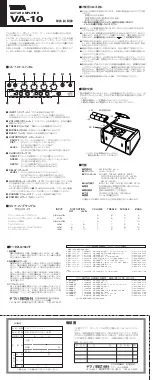
4
Optical Switch
The optical output jack of the DMPA can have one of two formats. When this switch is depressed
AND lit blue, this jack will output 8 channels of ADAT.
(ADAT cannot be output if the sample rate
exceeds 48KHZ - the Sample Rate selection being set to an internal rate). In this case the switch
cap will NOT be illuminated, and the output format will revert to 2-channel mode (TOSLINK).
When ADAT output is active, The left channel of the DMPA is output on CH1, the right channel of
the DMPA is CH2, and the rest of the channels consist of data received from the ADAT Input jack.
When the switch is in the OUT position OR the switch cap is not lit, the output consists of two
channels of digital audio in the format selected by the Sample Rate Switch.
The Lighting of the optical switch cap serves a second function. If it is blinking, there is a timing
problem in the digital section. This usually happens when there is not a valid external timing input
selected.
Front Panel Connections
Instrument Inputs
The 1/4” jacks on the front panel serve as an instrument input. The input impedance is always
>1M Ohm and the gain can be adjusted by the Input Gain Control. The maximum input signal level
is +17dBu (5Vrms) @ minimum input gain.
When you plug into this jack it DISABLES the balanced input on the rear of the unit. This feature
allows you to keep the rear input patched in, and use the instrument input to switch to a different
source. The instrument input allows the DMPA to serve as a great DI device as well.
Rear Panel Connections
Balanced Inputs
The DMPA’s XLR connectors follow the AES standard of Pin 1 = Ground, Pin 2 = Hot (+), Pin 3 =
Cold (-). The Balanced inputs have an input impedance that is variable from 150 to 3K Ohms via
the front panel control. The Maximum input level is +19dBu balanced and +17dBu unbalanced.
Balanced Outputs
The DMPA ‘s flexible active balanced outputs are available on both 1/4” and cannon connectors.
They offer low impedance for driving long cable runs and are intelligent so they maintain the same
output level whether it is balanced or unbalanced.
The DMPA’s XLR connectors follow the AES standard of Pin 1= Ground, Pin 2= Hot (+), Pin 3=
Cold (-). The balanced 1/4” phone jacks are typical Tip = Hot (+), Ring = Cold (-), Sleeve = Ground
Maximum output level is +26 balanced and +20 unbalanced.
































